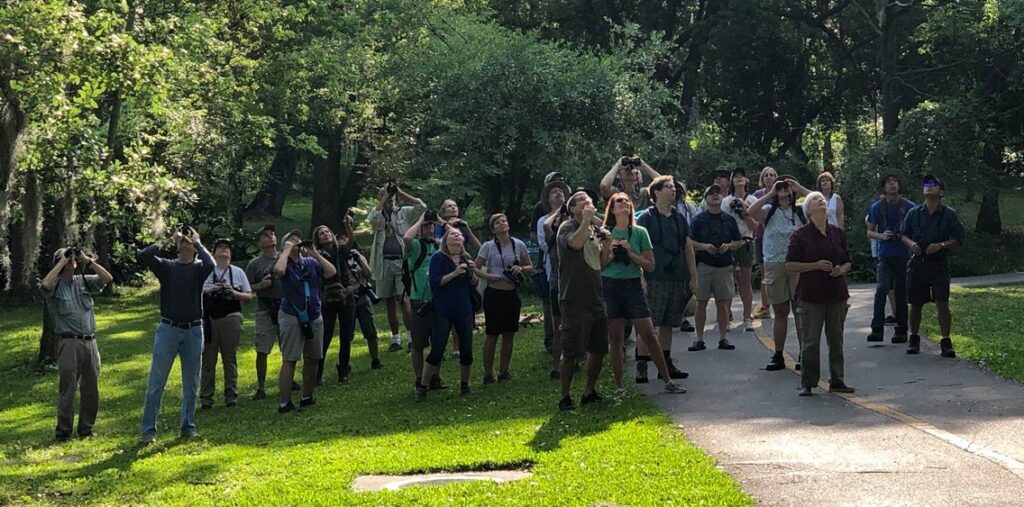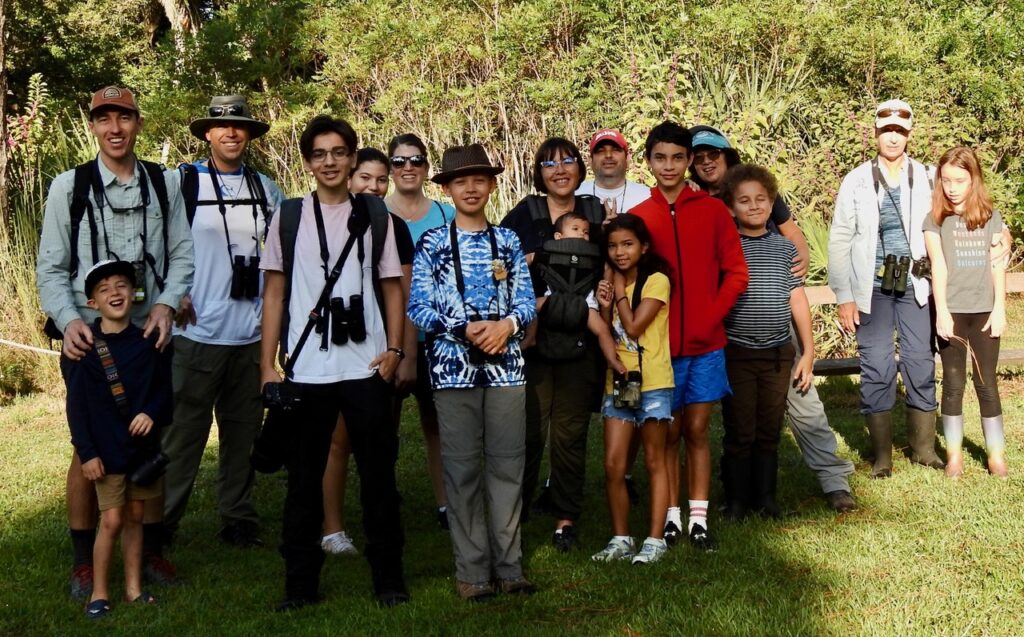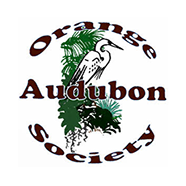Central Florida Birding Hotspots

Visit Central Florida any time of year and there’s something to see. In summer, look to the skies for Swallow-tailed Kites and to the wetlands for secretive Least Bitterns. In spring and fall, migratory warblers and shorebirds pass through. Fulvous and Black-bellied Whistling Ducks are year-round residents, while winter brings Lesser Scaup, Blue-winged Teal, Ring-necked Ducks, Ruddy Ducks, and others to the lakes and wetlands.
Here are a few of our top Central Florida birding sites, which include several Important Bird Areas. You can also check out the Great Florida Birding Trail and eBird to find additional popular birding destinations. Be sure to check each location’s website for the most up-to-date opening and closing times.
- Lake Apopka North Shore and the Wildlife Drive: On the NE shore of Lake Apopka, the St. Johns Water Management District wetland restoration area is a State Designated Important Bird Area featuring hiking, biking and an 11-mile Wildlife Drive through the restoration areas. It is one of Florida’s prime eBird hotspots. For the Drive, the front gate opens 7am to 3pm on Fri, Sat, Sun and major holidays. Schedule at least 1.5 hrs, more on holidays, for the drive. Specialties include Fulvous Whistling Ducks, Mottled Ducks, and Snail Kites with 281 eBird species listed. In season, Peregrine Falcons, Merlin, Northern Harriers and Kestrels patrol the park. Otters, Bobcats and many reptiles make their home here. 2850 Lust Road, Apopka, FL. Info: www.sjrwmd.com
- Wekiwa Springs State Park: Featuring a signature sandhill community, this park is maintained with prescribed burns making it a successful habitat for Bachman’s Sparrows, Red-headed Woodpeckers, Brown-headed Nuthatch, Carolina Chickadees, Pine Warblers and Great Horned Owls. Gopher Tortoise, Florida Black Bear, White-Tailed Deer and Sherman’s Fox Squirrels also live in the park. The springs area offers swimming, kayaking and tubing. The Park is part of the Wekiva-Ocala Greenway, a continental-designated Important Bird Area. Weekends can be very busy. Hours: 8am until sunset, 365 days of the year. 1800 Wekiwa Springs Circle, Apopka, FL. Info: www.floridastateparks.org/parks-and-trails/wekiwa-springs-state-park
- Mead Botanical Garden: This city park is a stop-over for migrating warblers in Spring and Fall and is part of the Great Florida Birding Trail. It’s a summer home to breeding Swallow-tailed Kites, and home to Barred Owls, Hawks, and waterbirds. Rarer migrants seen at the park in the past include Cerulean Warblers, Blue-winged Warblers, Kentucky Warblers and Philadelphia Vireos. Hours: 8am to 7pm, 7 days per week. 1300 S. Denning Dr., Winter Park, FL. Info: www.meadgarden.org
- Orlando Wetlands Park: One of the first human-made wetlands designed to provide advanced treatment for reclaimed water, it hosts nesting colonies of Roseate Spoonbills and Herons, Night-herons, Egrets, Purple Gallinules and Limpkins. Winter residents include dabbling ducks and Painted Buntings. Migrating warblers often stop by the wooded areas of the park. Short-tailed Hawks and Crested Caracara are often seen overhead or on the road to the park. Open 7 days/week, sunrise to sunset, for hiking, non-motorized biking, birding and photography. 25155 Wheeler Rd, Christmas, FL. Info: www.orlando.gov/Parks-the-Environment/Directory/Wetlands-Park
- Hal Scott Regional Preserve and Park: This property protects resources of the Econlockhatchee River and is an oasis in the rapidly growing Orlando area. Named for a former president and executive director of the Florida Audubon Society, a portion of this property was acquired by the St. Johns River Water Management District using funds from the Orlando-Orange County Expressway Authority and the Florida Department of Transportation as part of the mitigation for beltway construction. The county also contributed funding to establish a partnership that created this regional preserve. It is the home to the rare Red-cockaded Woodpecker. Bachman’s Sparrows, Bobwhite, Eastern Meadowlarks, Summer Tanagers, and Common Nighthawks are just a few of the finds. 5150 Dallas Blvd. Orlando, FL. Info: www.sjrwmd.com/lands/recreation/hal-scott/
- Tosohatchee Wildlife Management Area (WMA): Another Central Florida area on the Great Florida Birding Trail, this WMA hosts 60 miles of hiking trails and uses prescribed burns and hydrological restoration to keep this habitat healthy for a variety of wildlife and birds. Wetland birds can be seen along the Econlockhatchee River and wooded areas house Pileated, Downy, Red-headed, Hairy and Red-bellied Woodpeckers along with Northern Flickers and Yellow-bellied Sapsuckers in season. Surprise finds can include Yellow-billed Cuckoo, Crested Caracara, Yellow-crowned Night-heron, ChuckWill’s-Widow, King Rail, among others. Seasonal warbler migrants stop by on their travels north. Operated by the Florida Fish and Wildlife Conservation Commission this WMA is a State Designated Important Bird Area. 3365 Taylor Creek Rd, Christmas, FL Info: www.myfwc.com/recreation/lead/tosohatchee/
Central Florida Birding with Kids

Here are some great locations to visit with children, both young birders and those less interested. Be sure to check each location’s website for the most up-to-date opening and closing times.
- Lake Apopka Wildlife Drive: On the northeast shore of Lake Apopka. The driving option makes it easy to take children. Let them count the gators while you scan one of Florida’s top eBird hotspots. 2850 Lust Road, Apopka, FL. Additional information: www.sjrwmd.com
- Audubon Center for Birds of Prey: This Audubon Florida raptor rehabilitation center offers a great opportunity to see and compare raptors up close up, while learning about conservation. The center has “ambassador” birds of all common Florida raptors species, and in addition, Burrowing Owls, Mississippi and Swallow-tailed Kites, and Short-tailed and Broad-winged Hawks. There is a small entrance fee. Open Tuesday – Sunday, 10 am to 4pm. 1101 Audubon Way, Maitland, FL. Info: www.cbop.audubon.org
- Gatorland: Native herons and egrets, Wood Storks, Anhingas and others have rookeries where alligators protect nesting areas from raccoons. An occasional Roseate Spoonbill and Sandhill Crane may join the fray. Or you may watch a native vulture join a trainer on-stage, snagging bits of chicken that get dropped. Hours 10am to 6pm, 365 days/year. There are admission fees. 14501 S Orange Blossom Trail, Orlando, FL. Info: www.gatorland.com
- Lake Eola: You may not add a lot to your life list, but children will love finding the 5 different types of exotic swans in the park (posted signs help with the ID). Domestic, Egyptian and Graylag Geese join Florida native herons and egrets at this busy and surprisingly birdy park (check the island near the bandshell for roosting waders). In the winter, migrating ducks like Lesser Scaup and Hooded Mergansers join the fray. White Pelicans and terns may be joined by a Peregrine Falcon in winter. Playground and picnic areas are available. There is limited free parking. Hours: 6am to 12am. 512 E Washington St, Orlando, FL. Info: www.orlando.gov/Parks-the-Environment/Directory/Lake-Eola-Park
- Mead Botanical Garden: You’re never far from a bench or your car at this urban oasis, making it easy for small children. The botanical garden offer great splashes of colorful flowers in season that attract numerous butterflies. A sandhill restoration garden shows plants native to the original habitat. Make sure to bring your binoculars. 1300 S. Denning Dr., Winter Park, FL. Info: www.meadgarden.org

